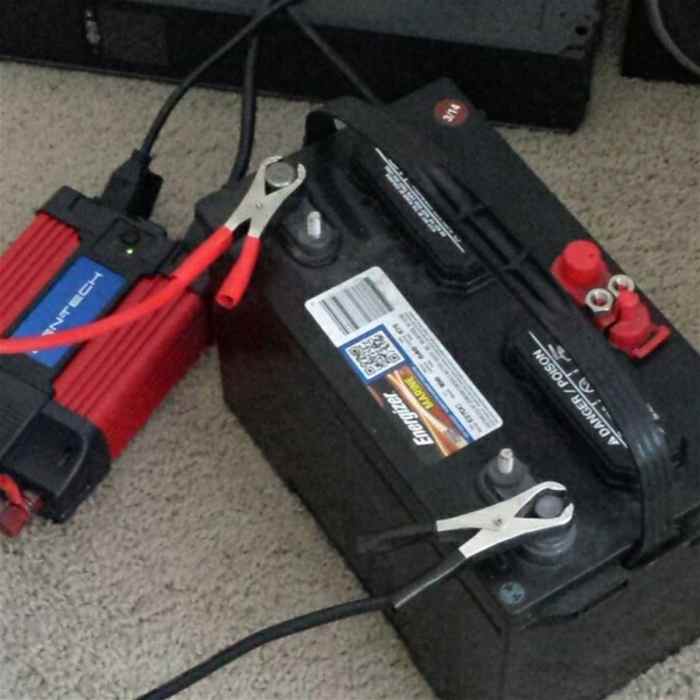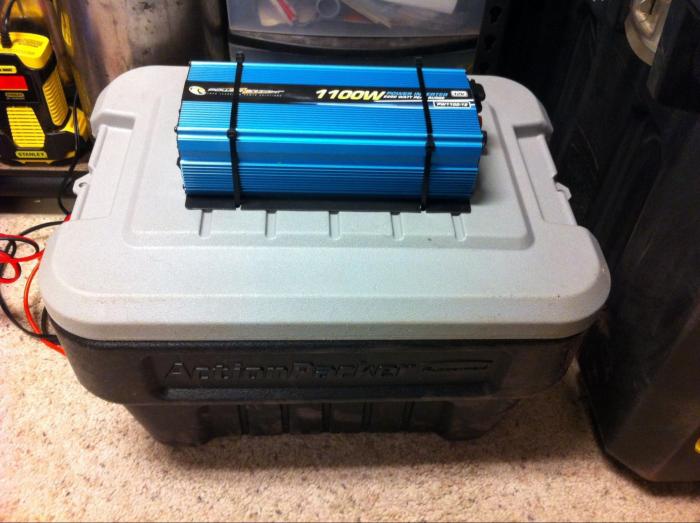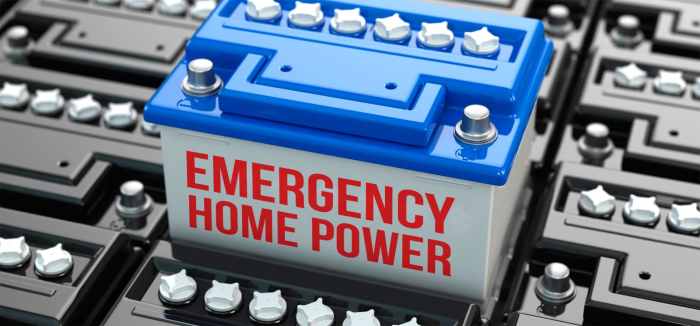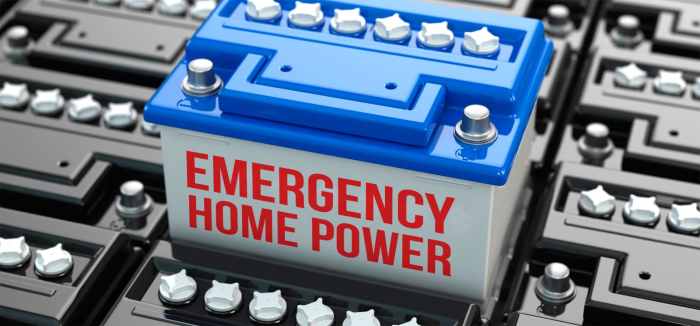DIY home battery backup offers a path to energy independence and peace of mind, empowering you to take control of your home’s power supply. Whether you’re seeking protection from outages or aiming to reduce reliance on the grid, building a DIY system can be a rewarding project.
This comprehensive guide explores the ins and outs of creating your own home battery backup system. From understanding different battery technologies to designing and installing your system, we’ll cover everything you need to know to embark on this exciting journey.
Types of Batteries for DIY Home Backup: Diy Home Battery Backup

Choosing the right battery technology for your DIY home backup system is crucial, as it will impact factors like cost, lifespan, efficiency, and safety. Understanding the pros and cons of each type will help you make an informed decision based on your specific needs and budget.
Lead-Acid Batteries
Lead-acid batteries are the most common and affordable type of battery for home backup systems. They are reliable and have a long history of use in various applications.
Pros of Lead-Acid Batteries
- Cost-effective: Lead-acid batteries are generally the cheapest option per kilowatt-hour (kWh) of storage capacity.
- Widely available: They are readily available at most automotive stores and online retailers.
- Durable: Lead-acid batteries can withstand high temperatures and harsh environments.
Cons of Lead-Acid Batteries
- Heavy: Lead-acid batteries are bulky and heavy, requiring robust mounting and support structures.
- Limited lifespan: They have a shorter lifespan compared to other battery technologies, typically lasting 3-5 years.
- Maintenance: They require regular maintenance, including topping off the electrolyte levels and checking for corrosion.
- Lower efficiency: Lead-acid batteries have lower energy efficiency compared to lithium-ion batteries.
- Safety concerns: They contain lead, which is a toxic substance, and can release flammable hydrogen gas if mishandled.
Examples of Lead-Acid Batteries for DIY Home Backup
- Deep-cycle batteries: These are specifically designed for frequent discharge and recharge cycles, suitable for home backup applications. Examples include batteries from brands like Trojan, Duracell, and Exide.
- Marine batteries: These are also suitable for deep-cycle applications and are known for their durability and resistance to vibration.
Lithium-Ion Batteries
Lithium-ion (Li-ion) batteries are rapidly gaining popularity for home backup systems due to their high energy density, long lifespan, and high efficiency.
Pros of Lithium-Ion Batteries
- High energy density: Li-ion batteries can store more energy in a smaller and lighter package compared to lead-acid batteries.
- Long lifespan: They have a longer lifespan, typically lasting 5-10 years or more, with thousands of charge cycles.
- High efficiency: Li-ion batteries have higher energy efficiency, meaning less energy is lost during charging and discharging.
- Fast charging: They can charge faster than lead-acid batteries.
- Environmentally friendly: Li-ion batteries do not contain lead and are generally considered more environmentally friendly.
Cons of Lithium-Ion Batteries
- Higher cost: Li-ion batteries are generally more expensive than lead-acid batteries, especially on a per kWh basis.
- Temperature sensitivity: They are more sensitive to extreme temperatures and may require temperature management systems.
- Safety concerns: Li-ion batteries can pose a fire hazard if mishandled or damaged, and they may require specialized safety precautions.
Examples of Lithium-Ion Batteries for DIY Home Backup
- Tesla Powerwall: This is a popular choice for residential backup systems, offering a high capacity and advanced features.
- LG Chem RESU: These batteries are designed for residential energy storage and are known for their reliability and performance.
- sonnenCore: This is another popular option, offering a modular design and customizable storage capacity.
Flow Batteries, Diy home battery backup
Flow batteries are a relatively new technology for home backup systems. They offer long lifespans and high safety but are currently more expensive than other options.
Pros of Flow Batteries
- Long lifespan: Flow batteries can last for 10-20 years or more, with thousands of charge cycles.
- High safety: They are inherently safer than other battery technologies, as they do not contain flammable or corrosive materials.
- Scalable capacity: Flow batteries can be easily scaled to meet specific energy storage needs.
Cons of Flow Batteries
- High cost: Flow batteries are currently the most expensive option per kWh of storage capacity.
- Large footprint: They require a larger physical footprint than other battery types.
- Limited power output: Flow batteries typically have a lower power output compared to Li-ion batteries.
Examples of Flow Batteries for DIY Home Backup
- Redflow ZCell: This is a popular flow battery for residential applications, offering a long lifespan and high safety.
- Primus Power EnergyPOD: This is another flow battery option designed for residential and commercial energy storage.
Installation and Wiring Techniques

Installing a DIY home battery backup system requires careful planning, adherence to safety standards, and knowledge of basic electrical wiring. This section provides a step-by-step guide for installing a DIY home battery backup system, emphasizing best practices for wiring the battery bank, inverter, charge controller, and connections to the home electrical system.
Safety Precautions
Safety is paramount when working with electricity. Before starting any installation, disconnect the main power supply to your home. This ensures that you are not working with live wires and reduces the risk of electric shock. Always wear appropriate personal protective equipment (PPE) such as rubber-insulated gloves and safety glasses. Keep a fire extinguisher nearby in case of an electrical fire.
Choosing the Right Location
The location of your battery backup system is crucial. It should be in a well-ventilated area, away from direct sunlight and sources of heat. The area should also be easily accessible for maintenance and repairs. Consider the weight of the battery bank and the space required for the inverter, charge controller, and other components.
Installing the Battery Bank
The battery bank should be securely mounted on a sturdy platform. The batteries should be connected in series or parallel depending on the desired voltage and capacity. Always refer to the manufacturer’s instructions for specific battery connections.
Wiring the Inverter
The inverter is responsible for converting DC power from the batteries to AC power for your home appliances. Connect the inverter to the battery bank using heavy-duty cables. Ensure that the cables are properly insulated and secured. Connect the inverter to your home’s electrical panel using a dedicated circuit breaker.
Connecting the Charge Controller
The charge controller regulates the charging current from the solar panels or other sources to the battery bank. Connect the charge controller to the battery bank and the solar panels using appropriate cables. Configure the charge controller according to the battery type and charging specifications.
Grounding the System
Grounding is essential for safety and protection against electrical faults. Connect the battery bank, inverter, and charge controller to a common ground point using a grounding rod or other approved grounding method. Ensure that the grounding system is properly installed and meets local electrical codes.
Connecting to the Home Electrical System
Connect the output of the inverter to a dedicated circuit breaker in your home’s electrical panel. This circuit breaker should be sized appropriately for the inverter’s output capacity. Use heavy-duty cables to connect the inverter to the electrical panel.
Testing and Commissioning
Once the installation is complete, test the system thoroughly. Charge the batteries fully and run appliances to ensure that the system is working correctly. Monitor the system regularly and check for any signs of malfunction.
Maintenance and Monitoring

A DIY home battery backup system requires regular maintenance to ensure optimal performance and longevity. Monitoring the system’s health and addressing potential issues promptly can prevent unexpected outages and extend the life of your batteries.
Routine Maintenance Schedule
A routine maintenance schedule helps ensure your DIY home battery backup system operates reliably. Here are some key tasks to include:
- Inspect Connections: Regularly check all connections, including those between the batteries, inverter, and your home’s electrical panel, for signs of corrosion, loose wires, or damage. Tighten any loose connections and address any corrosion immediately.
- Battery Terminal Cleaning: Clean battery terminals with a wire brush and baking soda solution to remove corrosion buildup. This ensures good electrical conductivity and prevents potential issues.
- Battery Water Levels (for Lead-Acid Batteries): If using lead-acid batteries, check the electrolyte levels regularly and top off with distilled water as needed. This prevents damage to the battery plates and extends battery life.
- Temperature Monitoring: Monitor the temperature of the battery bank. Extreme temperatures can negatively impact battery performance and lifespan. Ensure adequate ventilation and consider using cooling or heating systems if needed.
- System Performance Checks: Run periodic tests to ensure the inverter and battery bank are functioning correctly. Simulate a power outage and check that the system seamlessly switches to battery power and back to the grid.
Battery Testing Methods
Testing your batteries regularly helps identify potential issues and ensure they’re in good working condition. Here are some common testing methods:
- Voltage Measurement: Use a voltmeter to check the voltage of each battery. This provides a basic indication of the battery’s state of charge. A fully charged battery will have a voltage within the manufacturer’s specified range.
For example, a 12-volt lead-acid battery should have a voltage of around 12.6 volts when fully charged.
- Specific Gravity Test (for Lead-Acid Batteries): Use a hydrometer to measure the specific gravity of the electrolyte in each cell of a lead-acid battery. This test provides a more accurate assessment of the battery’s state of charge and overall health.
A fully charged lead-acid battery typically has a specific gravity of 1.265.
- Load Testing: Connect a load to the battery bank and measure the voltage drop. This test simulates the actual load your system will experience during a power outage. A significant voltage drop indicates a potential problem with the battery bank’s capacity.
Monitoring System Performance
Monitoring your system’s performance helps identify potential issues and optimize its efficiency. Here are some tips:
- Use a Battery Monitoring System: Install a battery monitoring system that tracks battery voltage, current, and state of charge. These systems can provide valuable insights into your battery bank’s health and performance.
- Log System Data: Regularly record key system parameters like battery voltage, current, and power consumption. This data can help identify trends and potential issues over time.
- Review System Logs: Regularly review the system’s logs to identify any error messages or unusual activity. Address these issues promptly to prevent potential problems.
Tips for Extending Battery Life
Extending the life of your batteries is crucial for maximizing the return on your investment. Here are some tips:
- Avoid Deep Discharges: Minimize deep discharges, as they can significantly shorten battery life. Ideally, keep the battery bank within a 20-80% state of charge range.
- Proper Charging: Charge batteries according to the manufacturer’s recommendations. Avoid overcharging or undercharging, as both can damage the batteries.
- Temperature Control: Maintain a consistent temperature within the battery bank’s optimal operating range. Extreme temperatures can significantly impact battery performance and lifespan.
- Regular Maintenance: Follow a regular maintenance schedule, including cleaning battery terminals, checking water levels (for lead-acid batteries), and performing periodic tests.
By taking the DIY route, you gain the satisfaction of crafting a custom solution tailored to your home’s energy needs. With careful planning, attention to safety, and a bit of technical know-how, you can create a reliable and cost-effective home battery backup system that provides peace of mind and enhances your energy independence.
Building a DIY home battery backup system can be a rewarding project, providing peace of mind during power outages. However, remember to prioritize safety and consult with a professional electrician for any complex wiring. While researching components for your system, you might come across information about medications like pantoprazole 20 mg , which is a proton pump inhibitor used to treat heartburn and acid reflux.
It’s important to note that these medications are unrelated to home battery backup systems, and any information about them should be consulted with a healthcare professional.

